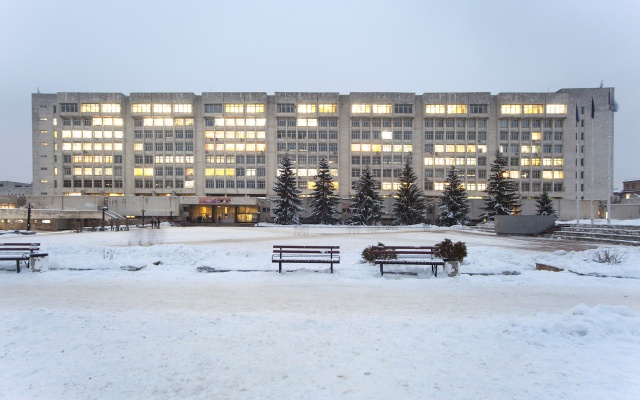First published in Ievgeniia Gubkina, 2019, “Losing my religion” – der ukrainische Sowjetmodernismus und wir, RGOW, no. 4–5, pp. 36–39. Revised for Obieg Magazine.
In the past decade, Soviet architecture has become a subject of interest among intellectuals all over the world. Meanwhile, in Ukraine, as a result of the political and economic circumstances that have developed and the entrenched stigma of the “Soviet,” this architecture is rapidly destroyed; it is at risk of total extinction. In 2019, Aleksey Bykov’s1 and my book Soviet Modernism. Brutalism. Post-Modernism. Buildings and Structures in Ukraine 1955–1991 was published by the Ukrainian publisher Osnovy and the German DOM. The book was a kind of architectural expedition for us. After a year of research and multiple encounters with reality, the work on the book changed our initial relationship with modernism. Architecture got entangled with human beings, their stories, landscapes, fates. It was coming to life, gaining flesh and subjectivity. We asked ourselves: In a situation of growing exploitation of the “ruin exoticism” of the Soviet period, where does our responsibility lie?
When we just started our research, our arrogant expectation was a naive confidence that the objects of our research should be, if hot high-quality, then at least medium-quality. In fact, we were dismayed at the extremely low quality of not just execution, but also design solutions. A researcher is tempted to slip into “collecting,” fanaticism or competition to demonstrate that their subject is the most unique, unusual, simply the best. These risks increase in view of the great number of recently printed publications that show Soviet modernism as something especially crazy, cosmic and entertaining. Following the principles of contemporary marketing, research risks turning into an exhibition of achievements, and its subjects into items for sale and commercialization. On the one hand, the realization of the unexpectedly poor quality of our research objects raises new questions about its causes. On the other hand, it gives us an understanding that our heritage owes us nothing, and that an object which we study, protect and even love does not have to be the best in the world.
In Soviet postwar architecture, the state system played a much greater role than the architects’ tastes. An enormous number of difficulties and obstacles constructed by the administrative apparatus of the command-and-control economy made creative expression, effective work process and independent decision making practically impossible for architects. In spite of this, the figure of a “star architect” can justifiedly be distinguished in Ukraine’s postwar architecture. Undoubtedly, this is Avraam Miletsky.2 A phenomenal personality who towers high over all the stylistic games and political changes. He was an architect capable not only of reflective architecture, but also of creating both an architectural statement and a comprehensive narrative, which comes together to make a unified big story. His heritage requires great attention and research, because it was created not thanks to, but in spite of—this is architecture of resistance.
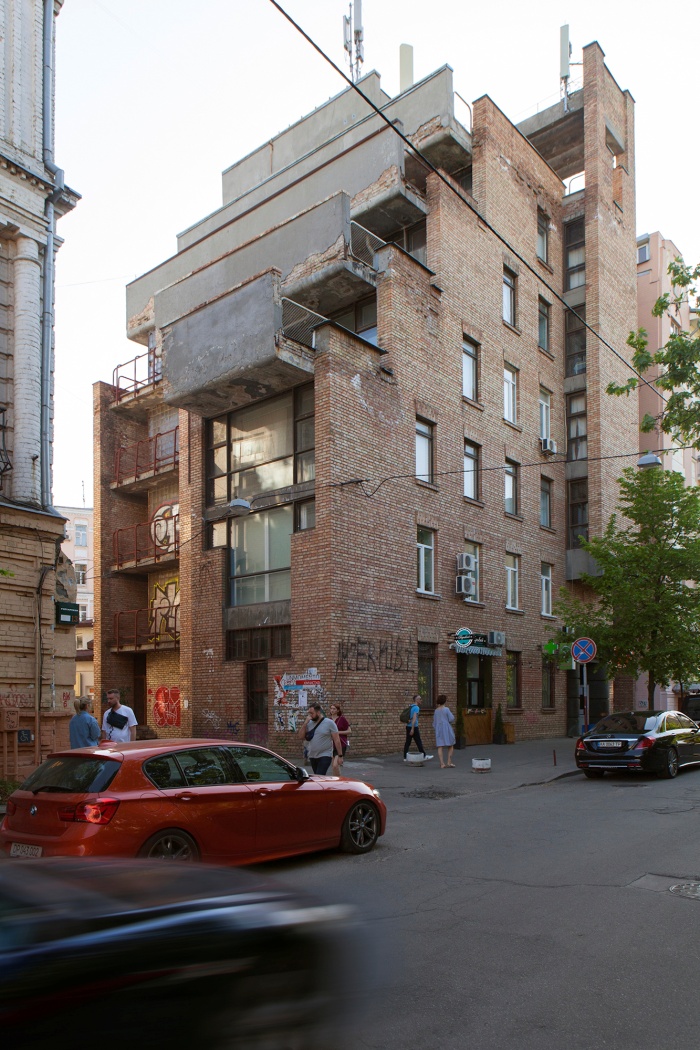
Poliklinika Narodowego Związku Pisarzy Ukrainy (1986), Kijów. Architekci: A. Milecki, N. Słohocka, W. Szewczenko. Zdjęcie: (c) Aleksiej Bykow, 2018.
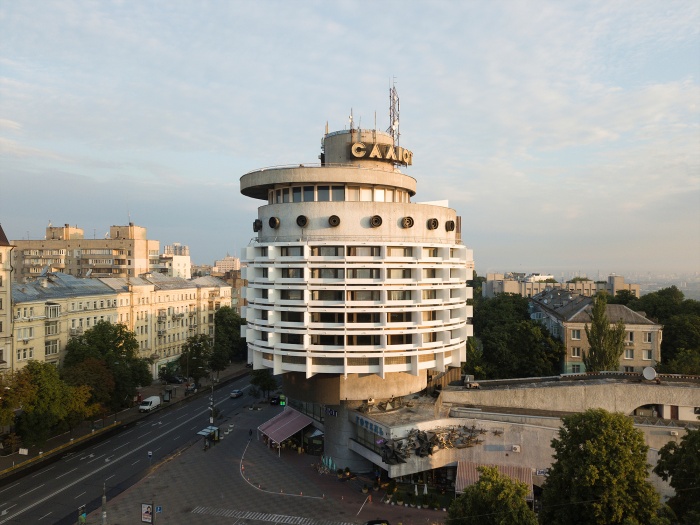
Hotel Salute (1976-1985), Kijów. Architekci: A. Milecki, N. Słohocka, W. Szewczenko. Inżynierzy: J. Szames, S. Syrota, J. Furmanow. Zdjęcie: (c) Aleksiej Bykow, 2018.
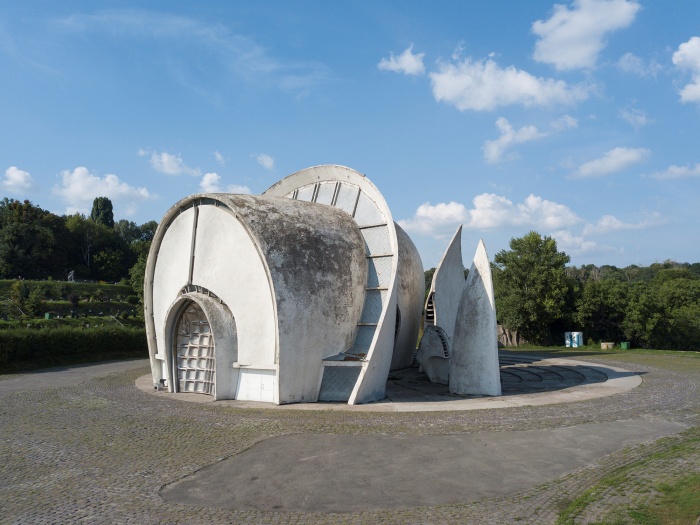
Sala pożegnań (krematorium), Park pamięci (1968-1981), Kijów. Architekt: A. Milecki. Zdjęcie: (c) Aleksiej Bykow.
When we talk about “Soviet modernism,” we assume that throughout the four decades, the architecture that was created remained practically the same; this is fundamentally wrong. Soviet architecture, just like any architecture in the world, went through the same stages and periods of development, but with its own characteristic features. When we apply the term “modernism” to all these structures, even at a cursory glance, it is impossible to notice the deep inconsistency of most of them with the basic principles of modernism. This is how either a mistake or a substitution of concepts happens. We expect to see the Second Wave of Modernism, which follows up on the principles of the modernist architecture of the 1920s–1930s, or try to find the architecture of the formidable and “militant” modernism of the “Empire of Evil.” We see Le Corbusier-style “machines to live in,” Mies van der Rohe’s doctrines, Kahn’s technocracy, infernality and utopianism of Soviet avant-garde where lightweight and frivolous sweet sixties structures are blooming or heavyweight and clumsy theaters and city halls of Brezhnev’s Stagnation Era are looming; they are unlikely to be declaring a new order of life, manifesting social change, not to mention seeking to lead everyone towards “Auschwitz.” This “modernism” is not the canonical modernism either in its goals or in its external characteristics. This produces a need to find an equivalent term. If, based solely on formal characteristics (such as “heavy weight”), we call the Brezhnev Stagnation heritage “brutalism,” we risk being trapped by our own expectations of it as a style with a rather “reliable reputation.” Here, we transfer our ideas about European brutalism to Soviet brutalism, ignoring its context, endowing its objects with all the “approved” features of an “approved” style. It doesn’t work like that with Soviet heritage.
Soviet heritage surprises us here, too: brutalism can be “bad.” It can be low-quality, made by not the most talented architects, it can have not the best or most refined goals which are far from the agenda of the “angry generation” of British brutalists. Moreover, it can even fundamentally contradict its very essence. For instance, it’s just not made of reinforced concrete. Soviet brutalism is made of low-quality bricks covered with decorative stone. Soviet brutalism is expensive, pompous, it doesn’t seek to achieve engineering innovations or to use the latest technology. It is conservative rather than progressive. It is a child of stagnation and the Cold War to a much greater extent than of architectural protest, not to mention social demand. The situation with postmodernism is the same. It isn’t always “good” and deeply intellectual, it can also be average, unremarkable, unreflective and even not funny. In short, it can be different.
There is a widespread stereotype that people don’t like Soviet architecture. As we travelled from city to city, from structure to structure, as we talked to a huge number of people from various social groups and with various degrees of involvement in the fate of the structures, we only heard positive comments about the architecture, indignation at its destruction, and most importantly, deep protest against the loss of socially and culturally significant functions performed by Soviet modernism. For decades, it’s been claimed both in global and in post-Sovier discourse that modernist architecture is crumbling because it isn’t understood or accepted by so-called “ordinary people”—that is, the users of the architecture.
By analyzing the contemporary system of decision making in architecture and urban planning, one can draw a simple but obvious conclusion: society or even activists do not make decisions whether a structure will be destroyed or will continue to function. In post-Soviet countries, decisions are made only by the authorities, based on their own goals or the goals of big business with which contemporary governments often have corrupt relations, while communities and activists are not just completely excluded from the decision making process, but also deprived of any chance of influencing it.
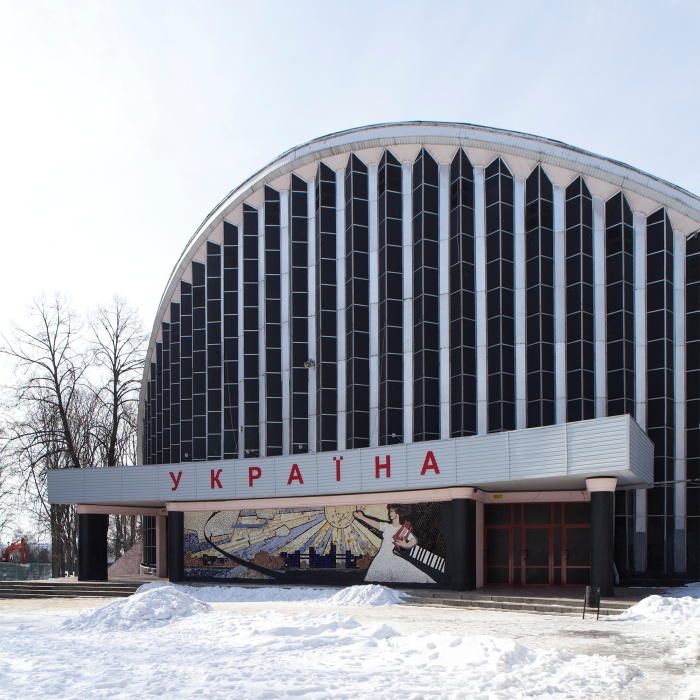
Kino Ukraina i Sala Koncertowa (1963), Charków. Architekci: W. Wasyliew, J. Płaskijew, W. Rieusow. Inżynier: L. Fridhan. Zdjęcie: (c) Aleksiej Bykow, 2018.
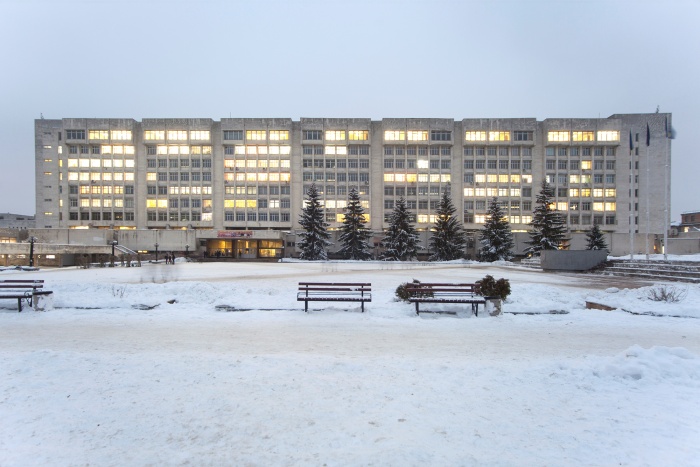
Biblioteka Politechniki Kijowskiej im. Ihora Sikorskiego (1973-1984), Kijów. Architekci: W. Lichowodow, W. Dowgaluk, W. Sidorienko, A. Dumczew, I. Dubasow, W. Pietrow, R. Gupało, W. Żdaniuk, W. Tisiejko, A. Zykow, W. Błomierius, W. Kriuczkow, A. Żukow. Inżynierzy: W. Nagornyj, E. Nazarienko, M. Wowk, Je. Kunda, D. Ganielin, G. Aleksiejewa, W. Martynienko. Zdjęcie: (c) Aleksiej Bykow, 2018.
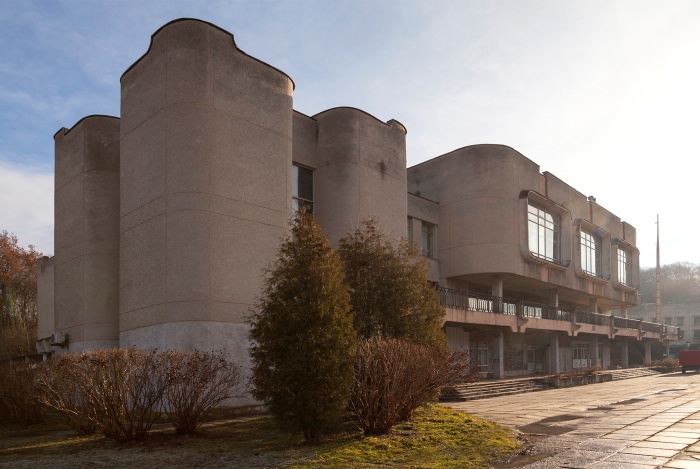
Centrum Kultury i Kreatywności dla Dzieci i Młodzieży (1984), Lwów. Architekci: A. Waszczak, M. Smietana, Z. Podlesnyj. Inżynier: W. Sprysa. Zdjęcie: (c) Aleksiej Bykow, 2018.
When we were just starting to work on our book, we were full of enthusiasm, hope and faith in our ability not just to study, but to act. We knew how to fix, improve and change everything. As engaged, caring researchers, we felt deeply amplified pain with every destruction. Our essence as architects, combined with the activist (read: political) component, demanded practical implementation, action and systematic solutions for problems. Pumped up with the postulates of “new urbanism,” theories of small actions and creative cities, various personal promotion and success training, know how workshops, we arrogantly sought to save someone and educate someone. But the rough reality and our “thousand attempts” demonstrated the complete impossibility of either saving or preserving the modernist heritage. It is impossible to change structural social phenomena, replace the decision making hierarchy, reform legislation and make everyone follow it if you’re in the position of an activist or a researcher. With limited toolkit, resource shortage and absolutely no access to power, we will not be able to change the situation in Ukraine. There is nothing we can do but admit the fact that the majority of postwar modernist structures in Ukraine will inevitably be destroyed in the nearest years. You could say, “But discussions, petitions, published books and other kinds of popularization must and can change the situation, right?” I doubt that. By assigning the role of the instruments of salvation to all of this, we confuse the roles, comfort ourselves with unrealizable hopes and substitute concepts. We throw every possible effort into fixing something that cannot be fixed by these means, into places where we don’t participate in decision making, which inevitably leads to frustration and disappointment.
The long-growing conflict with reality inevitably led to an unavoidable confrontation with it. In addition to the “conflict with reality,” we could not avoid a generational conflict. To our surprise, our path resulted in reconsideration of our attitudes to the previous generation—the generation of “our parents.” After the initial total antagonism, rejection or even condemnation, we suddenly realized in horror that we were facing the same situation and the same choices they had faced. Our confidence that everything would inevitably become better and that the world was progressing was replaced with a feeling of being trapped in a situation where all generations were running in the same circles. The solidarity which I used to feel with discriminated groups or my own peers across the world, with the international feminist community, with activists, was, for the first time, applied to the generation of my parents, to the generation of those whom I used to hold responsible for everything that was going on. This solidarity is the solidarity that results from encountering the same shit, the solidarity of the same pain, the same problem. Facing the same insurmountable obstacles builds a new type of connection with our “fathers” and “mothers.” On the one hand, this makes us think about how we could solve the homogenous, recurring problems that exist all over the world; on the other hand, it shifts the focus to ourselves. We told our “parents”: “Your statement is wrong!” But what kind of statement are we making? We said: “You’ve ruined everything!” But aren’t we also ruining everything in the same way? We said: “You lost your revolution!” But maybe right now we’re losing our own?
When we were starting our research and trying to answer the question of what modernism was, we faced the question of who we were. When we sought to gain confidence, we came out even more confused, but we cherish this confusion, and it gives us more hope than self-deception would.
Translated from Russian by Roksolana Mashkova
BIO
Ievgeniia Gubkina is an architect, architectural historian, curator of architectural and art projects, and educational events. She is a co-founder of the NGO Urban Forms Center and women’s avant-garde movement Modernistki. She graduated from the Kharkiv National Academy of Municipal Economy with a Master’s degree in urban planning. She developed and guided the tour “Linear City” in Kharkiv. Since 2012, she has been a consultant for Ukrainian Weeks of Constructivism in Zaporizhzhia; participated in conferences, and given lectures in Vienna, Berlin, Rotterdam, Tubingen, Chicago, Yerevan, Gdynia, Vilnius, Moscow, Cambridge,Dunaujvaros, Florence and in many cities in Ukraine. Gubkina is has authored a number of publications, including articles in Architekturführer. Kiew (DOM Publishers), Utopia & Collapse: Rethinking Metsamor (Park Books AG), ERA21, The Calvert Journal, Springerin, RGOW. She’s the author of Slavutych: Architectural Guide (2015, DOM Publishers, Germany) and co-author of the study and the book released in 2019 Soviet Modernism. Brutalism. Post-Modernism. Buildings and Structures in Ukraine 1955–1991.
*Cover photo: Library of Igor Sikorsky Kyiv Polytechnic Institute (1973-1984), Kyiv. Photo: (c) Alex Bykov.
[1] Aleksey Bykov is an architect, photographer, researcher of Soviet modernism architecture, co-curator of the Superstructure exhibition (2015), co-author of the book Soviet Modernism. Brutalism. Post-Modernism. Buildings and Structures in Ukraine 1955-1991 (2019), the author and host of his own radio program Author's Supervision.
[2] Avraam Miletsky (1918, Kyiv–2004, Ashkelon, Israel) was a Ukrainian Soviet architect, an honorary member of the Ukrainian Academy of Architecture. In 1969–1988, he was a professor at the architectural department of the Kyiv State Art Institute. He won the USSR State Prize for designing the Palace of Pioneers and Schoolchildren in Kyiv (1967). His architectural works include the monument at the location where Soviet and American allied troops met in Torgau on Elbe (Germany, 1945); the Writers Association Clinic in Kyiv on Reitarska Str. (1973); the Baikove Cemetery Crematorium (1975); the Salut Hotel in the Glory Square in Kyiv (1984) and others.



